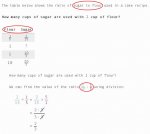I have a question about the 1st step on a problem on Khan Academy:

Since they took the reciprocal of 1/5, (which is 5/1) the result was 2/3
Had they taken the reciprocal of 2/15 instead, the result would have been 3/2, which is obviously a very different result.
So, clearly it matters which fraction they take the reciprical of. But they don't explain how they choose which fraction to take the reciprocal of!
So... how does one know which fraction to take the reciprocal of?

Since they took the reciprocal of 1/5, (which is 5/1) the result was 2/3
Had they taken the reciprocal of 2/15 instead, the result would have been 3/2, which is obviously a very different result.
So, clearly it matters which fraction they take the reciprical of. But they don't explain how they choose which fraction to take the reciprocal of!
So... how does one know which fraction to take the reciprocal of?
Last edited:

